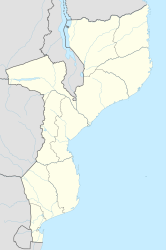Cuamba
| Cuamba | ||
|---|---|---|
|
|
||
| Coordinates | 14 ° 49 ′ S , 36 ° 33 ′ E | |
| Basic data | ||
| Country | Mozambique | |
| Niassa | ||
| ISO 3166-2 | MZ-A | |
| surface | 131 km² | |
| Residents | 75,000 (2006) | |
| density | 572.5 Ew. / km² | |
| founding | 1906 | |
|
Cuamba Town Hall
|
||
Cuamba - Nova Freixo between 1952 and 1976 - is a city ( município ) in the province of Niassa in northern Mozambique and the seat of the district of the same name . It is one of the largest cities in the Niassa Province and is an important transport hub in the Nacala Corridor between the Indian Ocean, Nampula and Malawi.
geography
Cuamba is located in the north of Mozambique and is in the south province of Niassa not far from the border with neighboring Malawi . It is the largest urban center of Niassa after the provincial capital Lichinga. In Cuamba live about 88,032 inhabitants (2010), at the 1997 census the National Statistics Office recorded 59,396 inhabitants.
The city has an area of 131.4 km². Monte Namuli is located near Cuamba .
history
The Companhia de Niassa - colonial concessionaire for the exploitation of the provinces Niassa and Cabo Delgado - founded the place Cuamba in 1906 as a military base. The name Cuamba (then still “Kuamba”) referred to a small tribal principality in the area.
In 1952, the Portuguese colonial administration changed the name of the place to "Nova Feixo" in honor of the Portuguese city of Freixo de Espada à Cinta , birthplace of the colonial governor Sarmento Rodrigues (1899–1979). After Mozambique gained independence in 1975, Cuamba got its original name back in 1976.
In 1971 the place received city rights from the colonial administration.
In the course of Mozambique's efforts to decentralize, the central government began to create so-called munizipe ( municípios ) in the 1990s . The central government created the municipality of Cuamba in 1997. In connection with this, the population of the city received the right to elect the city council ( concelho municipal ) themselves. In all local elections since 1998 the ruling party FRELIMO won the local elections in Cuamba. Zacarias Filipe (FRELIMO) has been ruling the city since an early election in January 2015, winning the election with 58.86% of the votes cast.
education
The Catholic University of Mozambique has an agricultural science faculty with 25 professors and 343 students in a renovated barracks building in Cuamba.
Economy and Infrastructure
Cuamba has its own hydroelectric power station in the nearby mountains. The city is on the Nacala – Nampula – Tete railway line (via Malawi), and the branch line to Lichinga begins in Cuamba. Cuamba is also on the EN8 national road to Nampula and Lichinga. The EN8 is not paved in the Niassa province, despite promises made by the central government.
Furthermore, Cuamba has a small airport with a 2800 meter long runway, but is not served by any commercial airline.
As the most important business location in the area, the place also has several banks ( Millenium bim , BCI , Standard Bank , Moza Banco), petrol stations and other shops.
Web links
Individual evidence
- ↑ a b Bernhard Weimer, Minoz Hassam, Ozias Chimunuane: Estudo sobre Potencial Tributário no Município da Cidade de Cuamba. MINISTÉRIO PARA A COORDENAÇÃO DA ACÇÃO AMBIENTAL, November 2010, accessed September 10, 2017 (Portuguese).
- ↑ ZACARIAS FILIPE PROCLAMADO PRESIDENTE DO MUNICÍPIO DE CUAMBA. (No longer available online.) Rádio Moçambique, February 2, 2015, formerly in the original ; Retrieved September 10, 2017 (Portuguese). ( Page no longer available , search in web archives ) Info: The link was automatically marked as defective. Please check the link according to the instructions and then remove this notice.
- ↑ Manuel David: Lichinga-Cuamba: Uma estrada esquecida pelo Governo? Deutsche Welle, January 31, 2017, accessed September 10, 2017 (Portuguese).



